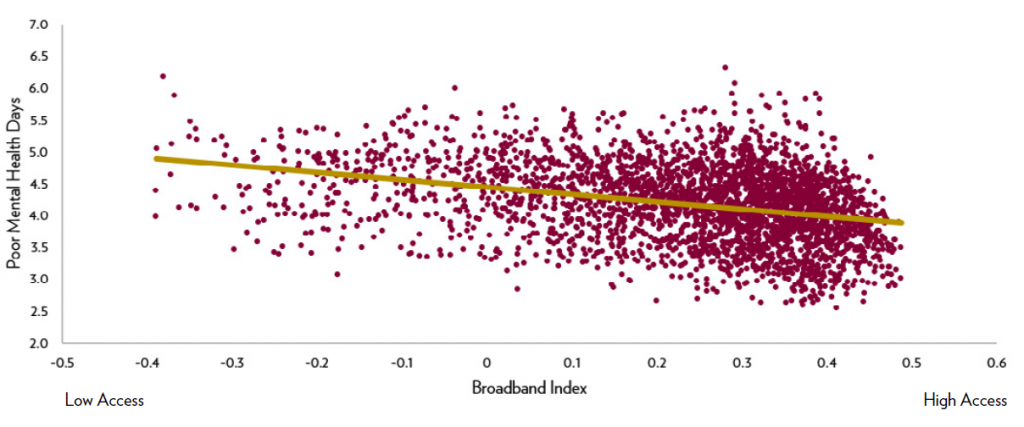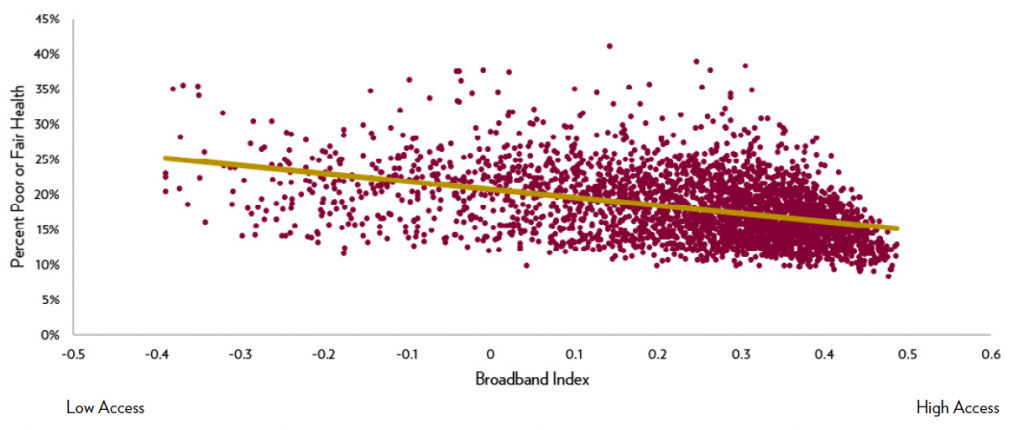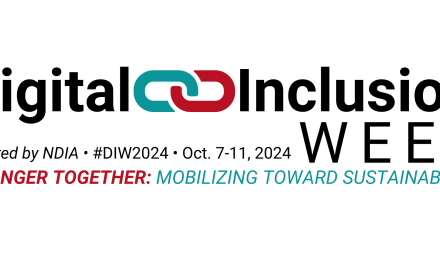Broadband is becoming increasingly important to community and economic wellbeing. Broadband access corresponds with improved health outcomes, which not only improves an individual’s quality of life, but can also lead to higher worker productivity. Broadband is also important to patients who are increasingly using telehealth to improve access to non-emergency medical care. Increasingly, practitioners can conduct “at-home” visits and access necessary technologies through the internet. These connections, however, require broadband level speeds and consistent connection quality. In rural and low-income areas that experience a relatively lower level of access to healthcare, telehealth services can be particularly useful provided broadband is available. Health outcomes can also increase through access to health care information such as internet-based counseling, coaching, and educational materials.
The potential link between broadband and health outcomes is a growing concern for many communities that lack access to the internet and broadband as it is widely accepted that individual health has both direct and indirect impacts on labor productivity (Deller, forthcoming), indicating that poor health outcomes can reverberate through the broader economy.
FIG 1: BROADBAND INDEX AND PERCENT REPORTING POOR OR FAIR HEALTH IN U.S. COUNTIES
Using data from the University of Wisconsin-Madison Population Health Institute reported in the County Health Rankings, Figures 1 and 2 demonstrate the correlation between broadband access and health outcomes. Figure 1 shows that, as access to broadband increases, the percentage of the population within counties in the United States that report poor or fair health decreases. Figure 2 similarly shows that as broadband access increases, the average number of days individuals report experiencing poor mental health by county decreases. In other words, broadband access has a relationship with self-reported mental and overall health.
FIG 2: BROADBAND INDEX AND NUMBER OF DAYS EXPERIENCING POOR MENTAL IN HEALTH U.S. COUNTIES

These correlations could be explained by other factors. For instance, lower-income households tend to have poorer health outcomes and lesser access to broadband. Individuals with higher levels of education also tend to have better health outcomes, and tend to concentrate in areas with higher levels of broadband access. An expanded regression analysis available in the full report, Broadband Internet and the Wisconsin Economy, confirms that broadband access improves health outcomes, even controlling for other factors. However, broadband and internet access is not as important to health outcomes as either the degree of ruralness or income levels.
The current COVID-19 pandemic may exacerbate this relationship between broadband access and health. For instance, the relationship to poor mental health days may increase during this period of isolation as the internet has become the primary means for which people remain connected to friends and non-immediate family members. The inability to “Facetime”, “Skype” or “Zoom” with friends and family while isolated can lead to higher rates of mental stress. Such stress can in turn compound other health issues. Additionally, people may be reducing the frequency of healthcare services by avoiding healthcare facilities where the risk of exposure to COVID-19 is higher. The inability to access telehealth due to lack of broadband could result in missing needed healthcare.
This work was supported by a grant from the United States Department of Commerce Economic Development Administration in support of Economic Development Authority University Center. Any opinions, findings, conclusions or recommendations expressed in this material are those of the authors and do not necessarily reflect the views of the U.S. Department of Commerce Economic Development Administration.
















